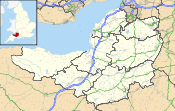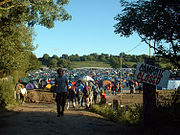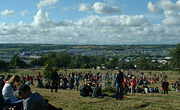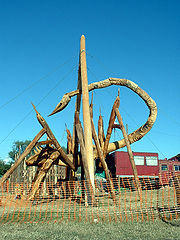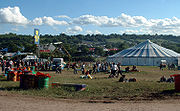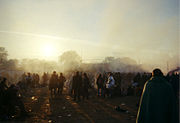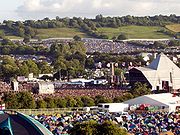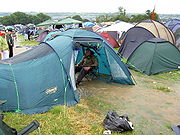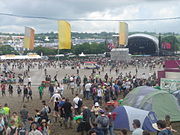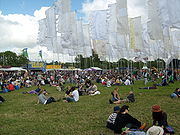
Glastonbury Festival
About this schools Wikipedia selection
Arranging a Wikipedia selection for schools in the developing world without internet was an initiative by SOS Children. See http://www.soschildren.org/sponsor-a-child to find out about child sponsorship.
| |
|
| Location(s) | Pilton, England, United Kingdom |
|---|---|
| Years active | Every year, except (usually) every 5th year |
| Date(s) | Last weekend of June (3 days) |
| Genre | Rock, world, electronic, Reggae, folk, hip hop |
| Website | glastonburyfestivals.co.uk |
The Glastonbury Festival of Contemporary Performing Arts, commonly abbreviated to Glastonbury or Glasto, is the largest greenfield music and performing arts festival in the world. The festival is best known for its contemporary music, but also features dance, comedy, theatre, circus, cabaret and many other arts. For 2005, the enclosed area of the festival was over 900 acres (3.6 km²), had over 385 live performances and was attended by around 150,000 people. In 2007, over 700 acts played on over 80 stages and the capacity expanded by 20,000 to 177,000.
For line-ups from previous years see Glastonbury Festival line-ups.
Overview
Glastonbury was heavily influenced by hippy ethics and the free festival movement in the 1970s, especially the Isle of Wight Festival. Organiser Michael Eavis stated that he decided to host the first festival, then called Pilton Festival, after seeing an open air Led Zeppelin concert at the Bath Festival of Blues and Progressive Music 1970 at the nearby Bath and West Showground in 1970. The festival retains vestiges of this tradition such as the Green Fields area which includes the Green Futures and Healing Field.
Location
Coordinates: 51.155015°N 2.585598°W
The festival takes place in South West England at Worthy Farm between the small villages of Pilton and Pylle, six miles east of the town of Glastonbury, overlooked by the Glastonbury Tor in the mystical "Vale of Avalon". The area has a number of legends and spiritual traditions, and is a "New Age" site of interest: several ley lines are considered to converge on the Tor. The nearest town to the festival site is Shepton Mallet, three miles (5 km) north east, but there continues to be interaction between the people espousing alternative lifestyles living in Glastonbury and the festival itself. The farm is situated between the A361 and A37 roads.
Worthy Farm is situated (map) in a valley at the head of the Whitelake River, between two low limestone ridges, part of the southern edge of the Mendip Hills. On the site is a confluence of the two small streams that make the Whitelake River. In the past the site has experienced problems with flooding, though after the floods that occurred during the 1997 and 1998 festival, drainage was improved (see Timeline below). This did not prevent flooding during the 2005 festival, but allowed the flood water to dissipate within hours. The Highbridge branch of the Somerset and Dorset Joint Railway ran through the farm on an embankment, but was dismantled in 1966 and now forms a main thoroughfare across the site. Another prominent feature is the high-voltage electricity line which crosses the site east-west.
In recent years the site has been organised around a restricted backstage compound, with the Pyramid stage on the north, and Other stage on the south of the compound. Attractions on the east of the site include the acoustic tent, comedy tent and circus. To the south are the green fields, which include displays of traditional and environmentally friendly crafts. In King's Meadow, the hill at the far south of the site, is a small megalith circle which, like Stonehenge, is coordinated with the summer solstice, and since 1990 represents a Stone circle.
Organisation
Since 1981, the festival has been organised by local farmer and site owner Michael Eavis (through his company Glastonbury Festivals Ltd). Eavis ran the festival with his wife Jean until her death in 1999, and is now assisted by his daughter Emily Eavis. Since 2002, Festival Republic (a company consisting of both Live Nation and MCD) has taken on the job of managing the logistics and security of the festival through a 40% stake in the festival management company. Each year a company, joint owned by Glastonbury Festivals Ltd and Festival Republic, is created to run the festival, with profits going to the parent companies. Glastonbury Festivals Ltd donates most of their profits to charities. The Festival Republic contract is a rolling one reviewed every five years.
Several stages and areas are managed independently, such as The Left Field which is managed by a cooperative owned by Battersea and Wandsworth TUC, Worthy FM and a field run by Greenpeace.
With the exception of technical and security staff, the festival is mainly run by volunteers. Some 1400 stewards are organised by the aid charity Oxfam. In return for their work at the festival Oxfam receive a donation, which in 2005 was £200,000. The bars are organised by the Workers Beer Company, sponsored by Carlsberg (previously Budweiser), who recruit teams of volunteer staff from small charities and campaign groups. In return for their help, typically around 18 hours over the festival, volunteers are paid in free entry, transport and food, while their charities receive the wages the volunteers earn over the event.
Catering, and some retail services, are provided by various small companies, typically mobile catering vans. The camping retail chain Millets, and many independent shops, set up makeshift outlets at the festival. Additionally many charities and organisations run promotional or educational stalls, such as the Hare Krishna vegetarian food stand. Network Recycling manage refuse on the site, and in 2004 recycled 300 tonnes and composted 110 tonnes of waste from the site.
Glastonbury over time
A series of concerts, lectures and recitals called the Glastonbury Festivals were established with a summer school in the town of Glastonbury between 1914 and 1926 by classical composer Rutland Boughton (1878-1960), and with their location attracted a bohemian audience by the standards of the time. They featured works by then-contemporary composers, sponsored by the Clark family, as well as a wide range of traditional works, from Everyman to James Shirley's Cupid and Death.
The next section is largely based on A Brief History of the Glastonbury Festival.
1970s
The first festival at Worthy Farm was the Pilton Festival, mounted by Michael Eavis in September 1970, and attended by 1,500 people. The first act to perform was the group Stackridge; the headline act was originally Wayne Fontana and the Mindbenders but this act was replaced at short notice by Tyrannosaurus Rex, later known as T.Rex.
The larger free festival at the summer solstice in June the next year was the first to attract nationwide interest, and the event became an important precursor of the later Glastonbury Festivals. The Glastonbury Fayre of 1971 was organised by Andrew Kerr with help from Arabella Churchill. The 1971 festival featured the first incarnation of the "Pyramid Stage" conceived by Bill Harkin, built from scaffolding and metal sheeting. Performers included David Bowie, Traffic, Fairport Convention, Quintessence, and Melanie. It was paid for by its supporters and advocates of its ideal, and embraced a mediaeval tradition of music, dance, poetry, theatre, lights and spontaneous entertainment. The 1971 festival was filmed by Nicolas Roeg and David Puttnam and was released as a film called simply Glastonbury Fayre.
In 1977 a more or less spontaneous event was held in Glastonbury by a mixture of tepee people, 'hippies' (called 'heads' by that time), musicians, students and general smokers. These events have no known recordings or press, and the details are undocumented.
There was a small unplanned event in 1978, when the convoy of vehicles from the Stonehenge festival was directed by police to Worthy Farm; the festival was then revived the following year (1979) by Churchill, Kerr and Eavis, in an event for the Year of the Child, which lost money.
1980s
The 1980s saw the festival become (barring periodic fallow years) an annual fixture.
In 1981, Michael Eavis took control of the festival for the first time, and it was organised in conjunction with the Campaign for Nuclear Disarmament (CND). That year a new Pyramid Stage was constructed from telegraph poles and metal sheeting (appropriately, repurposed from materials of the Ministry of Defence), a permanent structure which doubled as a hay-barn and cow-shed during the winter.
In the 1980s, the children's area of the festival (which had been organised by Arabella Churchill and others) became the starting point for a new children's charity called Children's World. 1981 was the first year that the festival made profits, and Eavis donated £20,000 of them to CND. In the following years, donations were made to a number of organisations, and since the end of the Cold War the main beneficiaries have been Oxfam, Greenpeace and WaterAid, who all contribute towards the festival by providing features and volunteers, who work at the festival in exchange for free entry.
Since 1983, large festivals have required licences from local authorities. This led to certain restrictions being placed on the festival, including a crowd limit and specified times during which the stages could operate. The crowd limit was initially set at 30,000 but has grown every year to over 100,000. In 1985, the festival grew too large for Worthy Farm, but neighbouring Cockmill Farm was purchased.
1985 saw a wet festival with considerable rain; Worthy Farm is a dairy farm and what washed down into the low areas was a mixture of mud and liquefied cow dung. This did not prevent festival-goers from enjoying the knee-deep slurry in front of the pyramid stage.
1990s
1990 saw the biggest festival yet; however, violence at the end of the festival between the security guards and new age travellers - the so-called Battle of Yeoman's Bridge - led to the organisers taking 1991 off to rethink the festival. An expanded festival returned in 1992, and this proved a great success. 1992 was the first year that the new age travellers were not initially allowed onto the site free, and a sturdier fence was designed. This success was carried through to 1993 which, like 1992, was another hot, dry year.
In 1994, the Pyramid Stage burned down just weeks before the festival; a temporary main stage was erected in time for the festival. The 1994 festival also introduced a 150 kW wind turbine which provided some of the festival power. This festival also included the setting of a new world record on 26 June when 826 people, juggling at least three objects each, kept 2,478 objects in the air. This was also the year the festival was first televised by Channel 4; concentrating on the main two music stages, it provided a glimpse of the festival for many who knew little of it. Channel 4 televised the following year as well, which proved to be very successful. 1994 was also the year that the British band The Levellers set the record for the highest ever stagefront crowd, which still stands to this day.
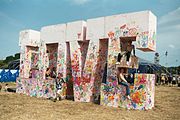
1995 saw the attendance rise drastically due to the security fence being breached on the Friday of the festival. Estimates suggest there may have been enough fence-jumpers to double the size of the festival. This aside, 1995 proved to be a highly successful year with memorable performances from Oasis, Pulp, PJ Harvey, Jeff Buckley and The Cure. This was also the first year of the festival having a dance tent to cater for the rise in popularity of dance music, following the success of Orbital's headline appearance the previous year.
The dance acts of 1995 were led by Massive Attack on the Friday and Carl Cox on the Saturday.
The festival took a year off in 1996 to allow the land to recover and give the organisers a break. This would be a pattern which would be followed every five years from now on. 1996 also saw the release of Glastonbury the Movie which was filmed at the 1993 and 1994 festivals. In that year, local artist Paul Branson established his Glastonbury Arts Festivals to provide a platform for classical works and put on a highly successful production of Rutland Boughton's opera The Immortal Hour at Strode Theatre as well as an art exhibition and a "son et lumière" at Glastonbury Abbey. These festivals, however, were short-lived.
The festival returned in 1997 bigger than ever. This time there was major sponsorship from The Guardian and the BBC, who had taken over televising the event from Channel 4. This was also the year of the mud, with the site suffering severe rainfalls which turned the entire site into a muddy bog. This caused many festival goers to leave early on the Friday, or not even bother to attend after radio and television reports gave details of just how muddy the site was. However those who stayed for the festival were treated to many memorable performances, including Radiohead's headlining Pyramid Stage set on the Saturday which is said to be one of the greatest ever Glastonbury performances.
In 1998 the festival was once again struck with severe floods and storms, again some festival goers departed early but those who stayed were treated to performances from acts such as Pulp, Robbie Williams and Blur. 1998 was also the first year that attendance officially broke the 100,000 mark.
1999 was a hot dry year, much to the relief of organisers and festival goers. Memorable performances from R.E.M., Fun Lovin' Criminals, Hole, Pavement and Al Green were among the highlights. Again, the festival was overcrowded due to fence-jumpers, this however would not be a major problem till the following year when the festival suffered from massive numbers of fence-jumpers. This surge increased the attendance to an estimated 250,000 people. The 1999 festival is also remembered for the Manic Street Preachers requesting and being given their own backstage toilets, however it was revealed by the band that this was a joke; the "reserved" sign on the toilet was not at the authorisation of the management.
2000s
2000
2000 saw a new Pyramid Stage introduced as well as several new features such as The Glade and The Leftfield. The festival was headlined by Pet Shop Boys and David Bowie playing 30 years after his first appearance. The Pyramid Stage also hosted an unusual event on the Saturday, with the wedding of Chelfyn & Helen Baxter conducted by actor Keith Allen (whose daughter Lily would perform at the 2007 and 2009 festivals). This year also saw an estimated 250,000 people attend the festival (only 100,000 tickets were sold) due to gatecrashers. This led to public safety concerns and the local District Council refused any further licences unless and until the problem could be solved.
2001
The organisers took 2001 off to devise anti-gatecrashing measures and secure the future of the festival, after the Roskilde Festival 2000 accident. It was at this point that the Mean Fiddler Organisation was invited to help.
2002
In 2002, the festival returned after a hiatus, with the controversial Mean Fiddler now handling the logistics and security — especially installing a substantial surrounding fence (dubbed the "superfence") that reduced numbers to the levels of a decade earlier. The lower attendance led to a much more relaxed atmosphere and massively reduced crime levels compared to previous years. There were some incidents outside the fence involving frustrated individuals who arrived at the festival assuming they would be able to jump the fence, but despite this the event was hailed as a great success by the media companies that had taken an interest in the festival. 2002 also saw Coldplay headline the Pyramid Stage for the first time. The show was closed by a set from Rod Stewart on the Sunday night. 2002 also saw the introduction of the inflatable cinema screen.
2003
By 2003, most people had accepted the idea that it was no longer possible to crash the festival and hence it is recognised as one of the most successful years to date. The number of tickets available to the public was increased slightly over 2002, partially in response to criticism that the 2002 festival was underpopulated and lacked atmosphere. The tickets sold out within one day of going on sale, in marked contrast to the two months it took to sell a similar number in 2002. It was also the first year that tickets sold out before the full lineup was announced. This was also the year Radiohead returned to headline the Pyramid Stage. Revenue raised for good causes from ticket and commercial licence sales topped £1 million, half of which went to Oxfam, Greenpeace and Water Aid.
2004
In 2004, tickets sold out within 24 hours amid much controversy over the ticket ordering process, which left many potential festival goers trying for hours to connect to the overloaded telephone and internet sites. The website got two million attempted connections within the first five minutes of the tickets going on sale and an average of 2,500 people on the phone lines every minute. The festival was not hit by extreme weather, but high winds on the Wednesday delayed entry, and steady rain throughout Saturday turned some areas of the site to mud. However Sir Paul McCartney's Saturday performance cheered many festival goers up. The festival ended with Muse headlining the Pyramid Stage on Sunday, after Oasis had headlined on Friday. Franz Ferdinand also performed.
After the 2004 festival, Michael Eavis commented that 2006 would be a year off — in keeping with the previous history of taking one "fallow year" in every five to give the villagers and surrounding areas a rest from the yearly disruption. This was confirmed after the licence for 2005 was granted.
2005
In 2005 the 112,500 ticket quota sold out rapidly — in this case in 3 hours 20 minutes, leaving many thousands of potential attendees frustrated.
The Sunday headliner was originally scheduled to be Kylie Minogue, who instead pulled out in May to receive treatment for breast cancer. Basement Jaxx were announced as a replacement on 6 June. Both Coldplay and Basement Jaxx performed a cover of Kylie's "Can't Get You Out Of My Head" during their concert. 2005 saw a big increase in the number of dance music attractions, with the multiple tents of the Dance Village replacing the solitary dance tent of previous years. This new area contained the East and West dance tents, the Dance Lounge, Roots Stage, and Pussy Parlure, as well as a relocated G Stage, formerly situated in the Glade. The introduction of the innovative silent disco by Emily Eavis allowed revellers to party into the early hours without disturbing the locals — a requirement of the festival's licensing. Following the death of DJ John Peel in the autumn of 2004, the New Tent was renamed the John Peel Tent, in homage to his encouragement and love of new bands at Glastonbury.
The opening day of the 2005 festival was delayed by heavy rain and thunderstorms: Several stages, including the Acoustic Tent (and one of the bars), were struck by lightning, and the valley was hit with flash floods that left some areas of the site under more than four feet of water. The severity of the weather flooded several campsites, the worst affected being the base of Pennard Hill, and seriously disrupted site services. However Mendip District Council's review of the festival called it one of the "safest ever" and gives the festival a glowing report in how it dealt with the floods.
Also this was the year that The Levellers set another record by having the biggest ever stagefront crowd for the Jazzworld stage. They now hold two records for the biggest crowds at the festival.
2006
There was no festival in 2006. Instead, a documentary film directed by Julien Temple was released to make up for the lack of a festival. The film consists of specially shot footage by Temple at the festival, as well as footage sent in by fans and archive footage. Glastonbury was released in the UK on 14 April 2006. Had the festival taken place that year, it would have taken place over a hot and sunny weekend, in a year surrounded by wet and muddy festivals.
2007
Glastonbury 2007 (20-24 June) was headlined by Björk, Arctic Monkeys, The Killers, and The Who on Friday, Saturday and Sunday, respectively. Dame Shirley Bassey was also featured. This was the first year that "The Park" area opened. Designed by Emily Eavis, its main stage featured extra sets by several artists playing on the main stages including Pete Doherty and Gruff Rhys, whilst the BBC launched their new "Introducing" stage in the area.
The festival had the largest attendance since the construction of the security fence, and the largest legitimate attendance to date: ticket allocation was raised by 27,500 to 137,500, which were charged at £145 and sold out in 1 hour 45 minutes. As an extra precaution against touts, purchasers had to pre-register, including submission of a passport photo which was security printed into the ticket. To reduce the number of attendees travelling by car, a portion of the tickets were tied to a mandatory coach travel deal, with ticket holders only being issued their tickets upon boarding the coach; these sold out slightly later than the others.
Continued periods of rain throughout much of the festival caused muddy conditions, though without the flooding of 2005, in part due to the new £750,000 flood defences. However this constant rain made the general conditions within the site worse than 2 years before and more like the mud plains of 1998. It was difficult to find anywhere to sit down that had not turned to mud and key choke points, such as the thoroughfare at the front right of the Pyramid stage, turned into a quagmire. Muddy conditions on many of the temporary roads on the periphery of the site led to delays for many people leaving the site.
On 25 June, when the vast majority of festival goers were attempting to leave the festival, cars in the western car parks took over nine hours to exit the site. There was no stewarding provision in these areas, no information was disseminated regarding the delays, no organised marshalling of traffic was undertaken by the festival organisers, and no provision of drinking water was made to people stranded in their vehicles. Verbal and physical violence was witnessed between festival goers. When cars were finally allowed to leave the site the surrounding roads were found to be clear.
Reported crime was down from 2005 but the number of arrests were "well up", after a proactive operation of the police and security on site. There were 236 reported crimes, down from 267 in 2005; of these, 158 were drug related (183 in 2005). This new emphasis on security was visible on arrival with many people having their belongings searched, something that had not been seen at Glastonbury before. One of the more unusual crimes was the impersonation of stewards on the second night in the area surrounding the Other Stage. There were, perhaps surprisingly, just 15 complaints in total, with only 8 of those relating to noise levels. 1,200 people required medical aid with 32 hospitalised, most of which were accidents caused by the mud. There was one fatality: a West Midlands man found unconscious early on the Saturday morning died in Yeovil District Hospital of a suspected drugs overdose.
This year saw a rise in the number of people leaving their tents and personal belongings as donations to the Global Hand charity's "Give Me Shelter" campaign, which aimed to use the tents to meet needs internationally. However, due to weather damage only a small proportion of the tents were used. The ICount charity also announced that they had over 70,000 people join their "Stop Climate Chaos" campaign.
On 20 December 2007, Arabella Churchill, an instrumental figure in the conception of the 1971 festival and since the 1980s area coordinator of the Theatre Field, died at St Edmund's Cottages, Bove Town, Glastonbury at the age of 58. She had suffered a short illness due to pancreatic cancer, for which she had refused chemotherapy and radiotherapy. She was a convert to Buddhism, and arrangements following her death respected her belief. Michael Eavis, paying tribute to her after her death, said "Her vitality and great sense of morality and social responsibility have given her a place in our festival history second to none".
2008
The festival was held on 27, 28 and 29 June, headlined by Kings of Leon, Jay-Z and The Verve on Friday, Saturday and Sunday, respectively. with other notable acts including Neil Diamond, Shakin' Stevens, The Levellers, The Johnsons and Stackridge, who opened the first festival in 1970.
Continuing the procedure introduced in 2007, ticket buyers had to pre-register and submit a passport photo between the 1 February and 14 March in order to buy tickets which went on sale at 9am on Sunday 6 April. Following 40,000 tickets not being sold, the pre-registration process was re-opened on 8 April. Several reasons have been cited for this, including the poor weather of the previous four years and the controversial choice of featuring the hip hop artist, Jay-Z, as a headlining act.. A day before the festival began, Michael Eavis announced that there were still around 3,000 tickets remaining, making it possible that it would be the first festival in 15 years not to sell out in advance. It had also been announced that any remaining tickets would be sold from major branches of HMV.
This year saw the introduction of a new field adjacent to the Sacred space and Park Stage. Not named by the organisers, the festival goers themselves called it "Flagtopia" in reference to the flags located there. "Flagtopia" is higher than the Sacred space and offers better views of the festival. The sunny weather throughout Saturday and Sunday dried up the Friday mud and helped to reduce problems.
After the huge number of tents left behind in 2007 and when one of Michael Eavis's cows died after ingesting a metal tentpeg left in the soil, the Festival devised its Love the Farm, Leave No Trace campaign which gently pushed revellers to respect the environment and clear up after themselves. The Festival had always pushed a green agenda and new initiatives in 2008 included biodegradable tent pegs handed out free to all campers and biotractors running on waste vegetable oil. These new efforts were rewarded with The Greener Festival Award for 2008 alongside a number of other festivals also committed to environmentally friendly music festivals.
The 2008 festival was reported to have cost £22 million to produce.
2009
The Glastonbury Festival 2009 took place between 24 and 28 June 2009. In marked contrast with previous years, the 137,500 tickets went on sale on 5 October 2008, earlier than ever before, with pre-registered customers able either to pay in full, or place a £50 reserve deposit to be paid by 1 February. Tickets for the festival sold out. The full line up was released on 25 May 2009 and included headliners Blur, Bruce Springsteen and Neil Young on the Pyramid stage. The Other stage was headlined by The Prodigy, Pendulum, Maxïmo Park, Bloc Party and Franz Ferdinand. Other notable performers included Rolf Harris, Fairport Convention (who played at the very first Glastonbury Festival), Steel Pulse, Doves, Lady Gaga, Jason Mraz, Nick Cave, Pete Doherty, Hugh Cornwell, Maximo Park, Status Quo, The Gaslight Anthem (in which Springsteen appeared on stage during their song " The '59 Sound"), Madness, Dizzee Rascal, Crosby, Stills & Nash, Lily Allen, Kasabian, Florence and the Machine. Spinal Tap one of a total of two shows worldwide on their Back From The Dead "World Tour".
Initially predicting fine weather the forecasts were unanimous and unwavering during the preceding week — three days of rain. However, after a heavy shower over Thursday night and Friday morning creating some mud, the second half of Friday and all of Saturday were sunny, very hot and dry. Despite some heavy, thundery showers on Sunday night, Glastonbury 2009 defied the forecasts to enjoy some of the best ever Glastonbury weather.
2010
The Glastonbury Festival 2010 will take place between 23 and 27 June 2010. Tickets went on sale on 4 October 2009, with the £50 deposit scheme introduced at the previous festival being continued. Unlike the previous two years and more incommon with earlier festivals, the tickets for the 2010 Glastonbury had sold out in less than 24hours from being released for sale. U2 will headline the Pyramid Stage on Friday night at Glastonbury 2010. Muse and Stevie Wonder will play the other two headline slots, with Muse playing on Saturday and Wonder on Sunday.
